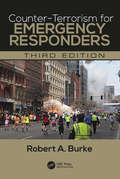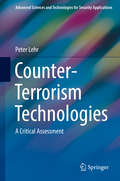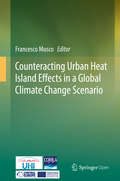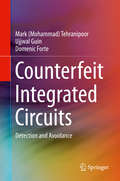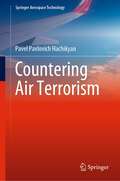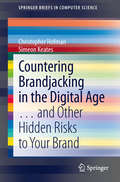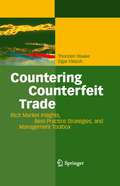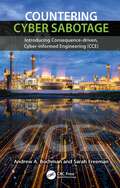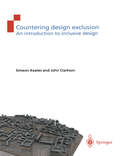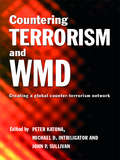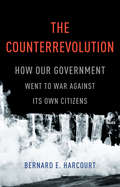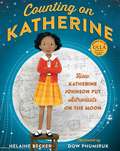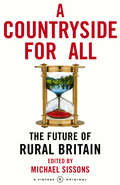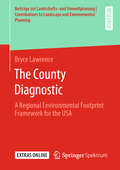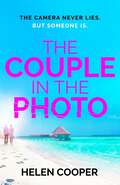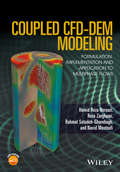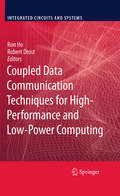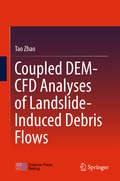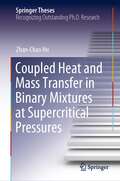- Table View
- List View
Counter-Terrorism for Emergency Responders
by Robert A. BurkeUsing the authors many years of experience in emergency services and his skills as a hazardous materials consultant, prepares the first responder to handle everything from re-establishing control and on-scene triage to investigating the crime. Including information on pre-incident and avoidance tactics, the author also discusses monitoring and detection techniques, protective equipment and decontamination, and an extensive list of resource organizations and training opportunities. This up-to-date 3rd edition is written to provide concise information for emergency responders who might be called upon to confront explosive, chemical, nuclear, biological, or incendiary acts of terrorism.
Counter-Terrorism for Emergency Responders
by Robert A. BurkeUsing the authors many years of experience in emergency services and his skills as a hazardous materials consultant, prepares the first responder to handle everything from re-establishing control and on-scene triage to investigating the crime. Including information on pre-incident and avoidance tactics, the author also discusses monitoring and detection techniques, protective equipment and decontamination, and an extensive list of resource organizations and training opportunities. This up-to-date 3rd edition is written to provide concise information for emergency responders who might be called upon to confront explosive, chemical, nuclear, biological, or incendiary acts of terrorism.
Counter-Terrorism Technologies: A Critical Assessment (Advanced Sciences and Technologies for Security Applications)
by Peter LehrThis book critically discusses the role of technology for counter-terrorism in general, and for securing our vulnerable open societies in particular. It is set against the backdrop of the terrorist threat posed by the combined forces of Al Qaeda and ISIS/Daesh in the foreseeable future. The book commences by illuminating current and foreseeable tactics and weapons used by these implacable enemies – weapons that may well include chemical, biological, radiological and potentially even nuclear (CBRN) devices. In a second part, it introduces technologies already available or in development that promise an increase in safety and security when it comes to the dangers posed by these terrorists. This part also includes a critical discussion of advantages and disadvantages of such technologies that are, quite often, sold as a ‘silver bullet’ approach in the fight against terrorism. Controversies such as those triggered by the abuse of millimeter wave scanners deployed at several Western European airports will demonstrate that there are costs involved with regard to human rights. The third, analytical part takes the critical discussion further by arguing that the uncritical fielding of new surveillance and control technologies in parallel with the on-going outsourcing and privatization of key services of the state could well lead to dystopias as envisaged in a rather prescient way by the so-called cyperpunk novels of the 1980s. The book concludes with the question that any liberal democracy should ask itself: how far can we go with regard to hardening our societies against terrorist threats?
Counteracting Urban Heat Island Effects in a Global Climate Change Scenario
by Francesco MuscoUrban heat islands are a new type of microclimatic phenomenon that causes a significant increase in the temperature of cities compared to surrounding areas. The phenomenon has been enforced by the current trend towards climate change. Although experts consider urban heat islands an urgent European Union public health concern, there are too few policies that address it. The EU carried out a project to learn more about this phenomenon through pilot initiatives. The pilots included feasibility studies and strategies for appropriately altering planning rules and governance to tackle the problem of urban heat islands. The pilots were carried out in eight metropolitan areas: Bologna/Modena, Budapest, Ljubljana, Lodz, Prague, Stuttgart, Venice/Padova, and Vienna. The feasibility studies carried out in these pilot areas focused on the specific morphology of EU urban areas, which are often characterised by the presence of historical old towns.
Counterfeit Integrated Circuits: Detection and Avoidance
by Mark (Mohammad) Tehranipoor Ujjwal Guin Domenic ForteThis timely and exhaustive study offers a much-needed examination of the scope and consequences of the electronic counterfeit trade. The authors describe a variety of shortcomings and vulnerabilities in the electronic component supply chain, which can result in counterfeit integrated circuits (ICs). Not only does this book provide an assessment of the current counterfeiting problems facing both the public and private sectors, it also offers practical, real-world solutions for combatting this substantial threat. · Helps beginners and practitioners in the field by providing a comprehensive background on the counterfeiting problem;· Presents innovative taxonomies for counterfeit types, test methods, and counterfeit defects, which allows for a detailed analysis of counterfeiting and its mitigation;· Provides step-by-step solutions for detecting different types of counterfeit ICs;· Offers pragmatic and practice-oriented, realistic solutions to counterfeit IC detection and avoidance, for industry and government.
Countering Air Terrorism (Springer Aerospace Technology)
by Pavel Pavlovich HachikyanThis book examines the issues of ensuring anti-terrorist security of an aviation enterprise, provides a history of terrorism in the aviation sector, and analyzes the legal regulations. This book provides mathematical and mathematical–psychological models for reducing the risk of terrorist threats, which makes it possible to objectively increase the safety of air transport facilities, reduce the likelihood of terrorist attacks, save human lives and prevent significant material losses. The solutions of general humanistic problems proposed in the book—preventing accidents and preserving the world—are an original feature of the book, which allows one to treat it with the necessary attention and interest for the reader. The concept of anti-terrorist security of an aviation enterprise presented in this book has been widely tested and introduced into the activities of leading aviation enterprises, including the Interstate Aviation Committee (IAC), and has been used in the investigation of aviation accidents. This book is written for a wide range of audience associated with ensuring aviation transport security and for the end users of airlines—passengers, in order to expand their knowledge about the reliability of using air transport.
Countering Brandjacking in the Digital Age: … and Other Hidden Risks to Your Brand (SpringerBriefs in Computer Science)
by Christopher Hofman Simeon KeatesThe rise of the Internet and social media in particular offer great opportunities for brand owners to increase business and brand recognition. While this has clearly been of benefit to brand owners, who have seen a consequent rise in the value of their brands, it simultaneously makes those brands more attractive for exploitation or attack by others. Brand risks can come in many different types and this book provides examples of how these risks can arise as well as providing quantitative estimates of the adverse impacts that can result from such risks.Brand owners need to be aware of the risks and of the need to develop strategies for identifying and managing them. This book details the process by which a brand owner can develop a brand risk management process to protect a brand’s reputation and value. Rather than prescribe a one-size-fits-all approach, the authors provide guidance on how a brand risk management process can be tailored to particular needs and circumstances.This approach is underpinned by drawing on examples of best practice in the fields of risk management, interaction design and engineering design. This combined approach relies on developing an understanding of the risks faced by a particular brand owner, the full context of those risks and also the brand owner’s capabilities for identifying and managing those risks.This book contains many real-world examples and interviews with a number of brand owning organisations ranging from small companies to large multinationals.
Countering Counterfeit Trade: Illicit Market Insights, Best-Practice Strategies, and Management Toolbox
by Thorsten Staake Elgar FleischThe book constitutes a unique combination of in-depth insights into the counterfeit market, best-practice strategies, novel management tools, and product protection technologies. It provides both the insights required to develop effective brand and product protection strategies, and the insights that are required to effectively respond to counterfeit trade. Key benefits are the unbiased analysis of the counterfeit market, the strong focus on assisting practitioners to deal with the challenge, and the high standard of research that supports the presented findings.
Countering Cyber Sabotage: Introducing Consequence-Driven, Cyber-Informed Engineering (CCE)
by Andrew A. Bochman Sarah FreemanCountering Cyber Sabotage: Introducing Consequence-Driven, Cyber-Informed Engineering (CCE) introduces a new methodology to help critical infrastructure owners, operators and their security practitioners make demonstrable improvements in securing their most important functions and processes. Current best practice approaches to cyber defense struggle to stop targeted attackers from creating potentially catastrophic results. From a national security perspective, it is not just the damage to the military, the economy, or essential critical infrastructure companies that is a concern. It is the cumulative, downstream effects from potential regional blackouts, military mission kills, transportation stoppages, water delivery or treatment issues, and so on. CCE is a validation that engineering first principles can be applied to the most important cybersecurity challenges and in so doing, protect organizations in ways current approaches do not. The most pressing threat is cyber-enabled sabotage, and CCE begins with the assumption that well-resourced, adaptive adversaries are already in and have been for some time, undetected and perhaps undetectable. Chapter 1 recaps the current and near-future states of digital technologies in critical infrastructure and the implications of our near-total dependence on them. Chapters 2 and 3 describe the origins of the methodology and set the stage for the more in-depth examination that follows. Chapter 4 describes how to prepare for an engagement, and chapters 5-8 address each of the four phases. The CCE phase chapters take the reader on a more granular walkthrough of the methodology with examples from the field, phase objectives, and the steps to take in each phase. Concluding chapter 9 covers training options and looks towards a future where these concepts are scaled more broadly.
Countering Cyber Sabotage: Introducing Consequence-Driven, Cyber-Informed Engineering (CCE)
by Andrew A. Bochman Sarah FreemanCountering Cyber Sabotage: Introducing Consequence-Driven, Cyber-Informed Engineering (CCE) introduces a new methodology to help critical infrastructure owners, operators and their security practitioners make demonstrable improvements in securing their most important functions and processes. Current best practice approaches to cyber defense struggle to stop targeted attackers from creating potentially catastrophic results. From a national security perspective, it is not just the damage to the military, the economy, or essential critical infrastructure companies that is a concern. It is the cumulative, downstream effects from potential regional blackouts, military mission kills, transportation stoppages, water delivery or treatment issues, and so on. CCE is a validation that engineering first principles can be applied to the most important cybersecurity challenges and in so doing, protect organizations in ways current approaches do not. The most pressing threat is cyber-enabled sabotage, and CCE begins with the assumption that well-resourced, adaptive adversaries are already in and have been for some time, undetected and perhaps undetectable. Chapter 1 recaps the current and near-future states of digital technologies in critical infrastructure and the implications of our near-total dependence on them. Chapters 2 and 3 describe the origins of the methodology and set the stage for the more in-depth examination that follows. Chapter 4 describes how to prepare for an engagement, and chapters 5-8 address each of the four phases. The CCE phase chapters take the reader on a more granular walkthrough of the methodology with examples from the field, phase objectives, and the steps to take in each phase. Concluding chapter 9 covers training options and looks towards a future where these concepts are scaled more broadly.
Countering Design Exclusion: An Introduction to Inclusive Design
by Simeon L. Keates P. John ClarksonInclusive design, universal design and universal access are long standing, familiar terms with clear and laudable goals. However, their teaching and industrial uptake has been very limited. Many products still exclude users unnecessarily for reasons ranging from corporate insensitivity and the size of the market for inclusive products to the individual designer's inability to design them. This pragmatic approach to making inclusive design desirable to industry addresses these issues and discusses why existing methods have failed to be assimilated into industry. Through the use of case studies and examples, Countering Design Exclusion introduces the mind-set necessary to think through the challenges raised by inclusive design and to adapt their solutions to the needs of particular companies. The practical outlook will appeal to anyone who wishes to take account of the largest possible part of the population in their designs.
Countering Nuclear and Radiological Terrorism (Nato Security through Science Series B: #Vol. 7)
by Samuel Apikyan David DiamondSinc the dissolution of the Soviet Union the nuclear threats facing the world are complex and constantly evolving.This volume is structured to promote wide-ranging, multi-national exploration of critical technology needs and underlying scientific challenges to reducing the threat of nuclear/radiological terrorism; to illustrate through country-specific presentations how resulting technologies were used in national programs; and to outline the role of legal, policy and institutional frameworks in countering nuclear/radiological terrorism.
Countering Terrorism and WMD: Creating a Global Counter-Terrorism Network (Political Violence)
by Peter Katona Michael D. Intriligator John P. SullivanThis volume shows us that in order to deal with today’s Fourth Generation asymmetric warfare by terrorist groups using conventional arms and weapons of mass destruction, we need a new ‘global networked’ approach. The contributors examine the various attempts that have been made to counter the latest wave of terrorism, including the US strikes against Afghanistan and Iraq, President George W. Bush's declaration of a ‘war against terrorism’, the creation of the US Department of Homeland Security, and the 9/11 Commission. Drawing from our experience with ‘Terrorism Early Warning’ and the co-production of counter-terrorism intelligence, this book explains the need for such a network and shows how it could be formed. It compiles the opinions of experts from clinical medicine, public policy, law enforcement and the military. These expert contributors identify the nature of a global counter-terrorism network, show how it could be created, and provide clear guidelines for gauging its future effectiveness. This book will be of great interest to all students of terrorism studies, US national security, international relations, and political science in general.
Countering Terrorism and WMD: Creating a Global Counter-Terrorism Network (Political Violence)
by Peter Katona Michael D. Intriligator John P. SullivanThis volume shows us that in order to deal with today’s Fourth Generation asymmetric warfare by terrorist groups using conventional arms and weapons of mass destruction, we need a new ‘global networked’ approach. The contributors examine the various attempts that have been made to counter the latest wave of terrorism, including the US strikes against Afghanistan and Iraq, President George W. Bush's declaration of a ‘war against terrorism’, the creation of the US Department of Homeland Security, and the 9/11 Commission. Drawing from our experience with ‘Terrorism Early Warning’ and the co-production of counter-terrorism intelligence, this book explains the need for such a network and shows how it could be formed. It compiles the opinions of experts from clinical medicine, public policy, law enforcement and the military. These expert contributors identify the nature of a global counter-terrorism network, show how it could be created, and provide clear guidelines for gauging its future effectiveness. This book will be of great interest to all students of terrorism studies, US national security, international relations, and political science in general.
The Counterrevolution: How Our Government Went To War Against Its Own Citizens
by Bernard E. HarcourtMilitarized police officers with tanks and drones. Pervasive government surveillance and profiling. Social media that distract and track us. All of these, contends Bernard E. Harcourt, are facets of a new and radical governing paradigm in the United States -- one rooted in the modes of warfare originally developed to suppress anticolonial revolutions and, more recently, to prosecute the war on terror. The Counterrevolution is a penetrating and disturbing account of the rise of counterinsurgency, first as a military strategy but increasingly as a way of ruling ordinary Americans. Harcourt shows how counterinsurgency's principles -- bulk intelligence collection, ruthless targeting of minorities, pacifying propaganda -- have taken hold domestically despite the absence of any radical uprising. This counterrevolution against phantom enemies, he argues, is the tyranny of our age. Seeing it clearly is the first step to resisting it effectively.
Counting on Katherine: How Katherine Johnson Put Astronauts on the Moon
by Helaine BeckerWinner of the information book category of the UKLA Book Awards 2020.Katherine Johnson is the mathematical genius who helped make the historic Apollo 11 moon landings possible and made sure that Apollo 13 returned home safely when the mission was in critical danger. As a child, Katherine loved to count. She counted the steps on the road, the number of dishes and spoons she washed in the kitchen sink, everything! Boundless, curious, and excited by calculations, young Katherine longed to know as much as she could about maths, about the universe . . .Helaine Becker interviewed Katherine and her family for this authorized biography. From Katherine's early beginnings as a gifted student to her heroic accomplishments as a prominent mathematician at NASA, this is the true story of a groundbreaking African-American woman who went above and beyond what was expected of her in the 1960s, saving lives and making enormous contributions to history. Featuring Dow Phumiruk's gorgeous full-colour illustrations throughout.
A Countryside For All: The Future of Rural Britain
by Michael SissonsThe rural fuse has been lit. The countryside is tinder-dry. Post offices and banks, shops and schools are closing. Farmers are going out of business. Houses are becoming unaffordable as prices soar ad poverty grows. Pollution and over-exploitation are destroying landscapes. Many rural communities are on the verge of collapse. Some fear the foot- and - mouth crisis will prove to be the last straw. This book offers disturbing evidence of the background to the crisis.A Countryside For All is a rallying cry for action, pointing ways towards a presciption for the future. This volume tackles many of the issues in a variety of new and original ways. Possibly the most controversial and radical call is for the creation of a Department for the Countryside, with a Secretary of State for the Countryside- who would be responsible for setting a coherent set of policies to reverse the decline of rural Britain.This timely book outlines the main problems facing the countryside, and starts to bring together a balanced range of proposals. Thought-provoking, filled with common sense, often controversial but always fascinating, it points the way forward for the countryside, and for town and country as a whole.
The County Diagnostic: A Regional Environmental Footprint Framework for the USA (Beiträge zur Landschafts- und Umweltplanung I Contributions to Landscape and Environmental Planning)
by Bryce LawrenceThe county diagnostic method is a spatially explicit, unit specific, component expanded regional environmental footprint framework for the USA designed by Bryce Lawrence to compare the influence of ecoregions on poly‐factorial environmental footprints. This 'diagnostic assessment' quantifies and compares the flows of food, water, energy, carbon, municipal solid waste, wastewater and spatial extent of ecosystem conservation. The county diagnostic fills the gap in regional environmental planning in the USA by bridging urban and state level planning.
The Couple in the Photo: The gripping summer thriller about secrets, murder and friends you can't trust
by Helen Cooper'What a wild ride!' Reader review ⭐⭐⭐⭐⭐'Wow!... A page-turning domestic suspense that will keep you on the edge of your seat' Reader review ⭐⭐⭐⭐⭐'I inhaled it in one day... Fast-paced mystery with many twists and turns... I was guessing until the final few pages how all of the threads came together. I absolutely could not put it down' Reader review ⭐⭐⭐⭐⭐They're your best friends.Lucy and her husband do everything with their closest friends Cora and Scott. They've even bought a beach house together to enjoy summers with their kids. They're more than friends: they're family.They're hiding something.When a colleague passes around photographs from her honeymoon in the Maldives, Lucy is shocked to see Scott in one of the pictures, his arm around another woman.The truth will change everything.Then news breaks that the woman from the photograph has mysteriously vanished. Why was Scott there and what is he hiding?As Lucy looks for answers, her whole life begins to unravel. If the lies start here, where do they end?A totally gripping and absolutely addictive psychological thriller with a killer twist you will never see coming. Fans of Daniel Hurst, Freida McFadden and K.L Slater will be hooked from the very first page.Readers are gripped by The Couple in the Photo:'I mean, wow! Holy, moly, my head might have just spun right on off my shoulders!... This book delivers!' Reader review ⭐⭐⭐⭐⭐'EXCELLENT THRILLER... If you love thrillers, twisty stories and a great heroine, The Couple in the Photo is for you!' Reader review ⭐⭐⭐⭐⭐'A jaw dropping read which will continually shock you and the ending? Well, picture perfect!' Reader review ⭐⭐⭐⭐⭐'The very first page had me hooked and wanting more. This book was very fast-paced and I did not want to put it down. Each chapter had me guessing more and more until the end!! As soon as I thought I could guess the ending there was another twist... I read for 5 hours straight' Reader review ⭐⭐⭐⭐⭐Praise for The Couple in the Photo:'I was hooked from the first page and positively devoured this masterfully constructed tale of lies and deceit. An absolute must-read for all thriller fans: I LOVED it!' Sarah Bonner'A twisty and intriguing suspense filled with lies and secrets that will have you salivating for more. Her best yet' Mira V Shah
Coupled Boundary and Finite Element Methods for the Solution of the Dynamic Fluid-Structure Interaction Problem (Lecture Notes in Engineering #77)
by Siamak Amini Paul J. Harris David T. WiltonThis text considers the problem of the dynamic fluid-structure interaction between a finite elastic structure and the acoustic field in an unbounded fluid-filled exterior domain. The exterior acoustic field is modelled through a boundary integral equation over the structure surface. However, the classical boundary integral equation formulations of this problem either have no solutions or do not have unique solutions at certain characteristic frequencies (which depend on the surface geometry) and it is necessary to employ modified boundary integral equation formulations which are valid for all frequencies. The particular approach adopted here involves an arbitrary coupling parameter and the effect that this parameter has on the stability and accuracy of the numerical method used to solve the integral equation is examined. The boundary integral analysis of the exterior acoustic problem is coupled with a finite element analysis of the elastic structure in order to investigate the interaction between the dynamic behaviour of the structure and the associated acoustic field. Recently there has been some controversy over whether or not the coupled problem also suffers from the non-uniqueness problems associated with the classical integral equation formulations of the exterior acoustic problem. This question is resolved by demonstrating that .the solution to the coupled problem is not unique at the characteristic frequencies and that it is necessary to employ an integral equation formulation valid for all frequencies.
Coupled CFD-DEM Modeling: Formulation, Implementation and Application to Multiphase Flows
by Hamid Reza Norouzi Reza Zarghami Rahmat Sotudeh-Gharebagh Navid MostoufiDiscusses the CFD-DEM method of modeling which combines both the Discrete Element Method and Computational Fluid Dynamics to simulate fluid-particle interactions. Deals with both theoretical and practical concepts of CFD-DEM, its numerical implementation accompanied by a hands-on numerical code in FORTRAN Gives examples of industrial applications
Coupled CFD-DEM Modeling: Formulation, Implementation and Application to Multiphase Flows
by Hamid Reza Norouzi Reza Zarghami Rahmat Sotudeh-Gharebagh Navid MostoufiDiscusses the CFD-DEM method of modeling which combines both the Discrete Element Method and Computational Fluid Dynamics to simulate fluid-particle interactions. Deals with both theoretical and practical concepts of CFD-DEM, its numerical implementation accompanied by a hands-on numerical code in FORTRAN Gives examples of industrial applications
Coupled Data Communication Techniques for High-Performance and Low-Power Computing (Integrated Circuits and Systems)
by Ron Ho Robert DrostWafer-scale integration has long been the dream of system designers. Instead of chopping a wafer into a few hundred or a few thousand chips, one would just connect the circuits on the entire wafer. What an enormous capability wafer-scale integration would offer: all those millions of circuits connected by high-speed on-chip wires. Unfortunately, the best known optical systems can provide suitably ?ne resolution only over an area much smaller than a whole wafer. There is no known way to pattern a whole wafer with transistors and wires small enough for modern circuits. Statistical defects present a ?rmer barrier to wafer-scale integration. Flaws appear regularly in integrated circuits; the larger the circuit area, the more probable there is a ?aw. If such ?aws were the result only of dust one might reduce their numbers, but ?aws are also the inevitable result of small scale. Each feature on a modern integrated circuit is carved out by only a small number of photons in the lithographic process. Each transistor gets its electrical properties from only a small number of impurity atoms in its tiny area. Inevitably, the quantized nature of light and the atomic nature of matter produce statistical variations in both the number of photons de?ning each tiny shape and the number of atoms providing the electrical behavior of tiny transistors. No known way exists to eliminate such statistical variation, nor may any be possible.
Coupled DEM-CFD Analyses of Landslide-Induced Debris Flows (Springer Tracts in Civil Engineering)
by Tao ZhaoThis book reflects the latest research results in computer modelling of landslide-induced debris flows. The book establishes an understanding of the initiation and propagation mechanisms of landslides by means of numerical simulations, so that mitigation strategies to reduce the long-term losses from landslide hazards can be devised. In this context, the book employs the Discrete Element Method (DEM) and Computational Fluid Dynamics (CFD) to investigate the mechanical and hydraulic behaviour of granular materials involved in landslides – an approach that yields meaningful insights into the flow mechanisms, concerning e.g. the mobilization of sediments, the generation and dissipation of excess pore water pressures, and the evolution of effective stresses. As such, the book provides valuable information, useful methods and robust numerical tools that can be successfully applied in the field of debris flow research.
Coupled Heat and Mass Transfer in Binary Mixtures at Supercritical Pressures (Springer Theses)
by Zhan-Chao HuSupercritical pressure fluids have been exploited in many engineering fields, where binary mixtures are frequently encountered. This book focuses on the coupled heat and mass transfer in them, where the coupling comes from cross-diffusion effects (i.e., Soret and Dufour effects) and temperature-dependent boundary reactions. Under this configuration, three main topics are discussed: relaxation and diffusion problems, hydrodynamic stability, and convective heat and mass transfer. This book reports a series of new phenomena, novel mechanisms, and an innovative engineering design in hydrodynamics and transport phenomena of binary mixtures at supercritical pressures. This book covers not only current research progress but also basic knowledge and background. It is very friendly to readers new to this field, especially graduate students without a deep theoretical background.
